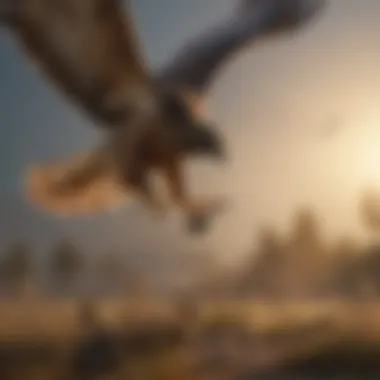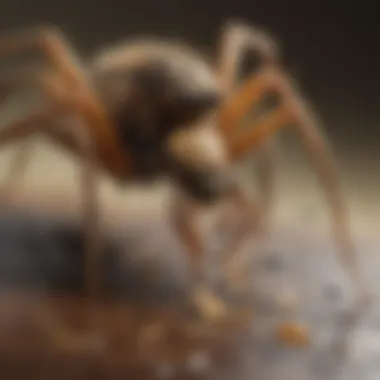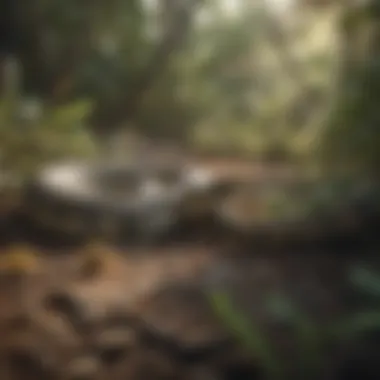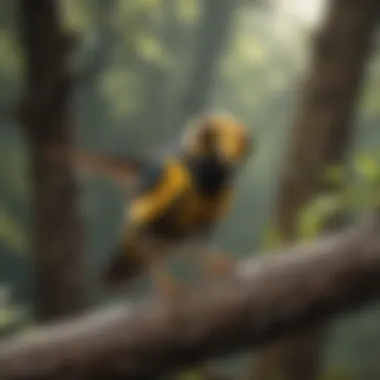Understanding Wasps' Predators and Ecosystem Roles


Intro
Wasps, often regarded as mere nuisances, play an important role in various ecosystems. However, they are not merely left to their own devices; they face a multitude of predators. Understanding these predators goes beyond just identifying who or what eats wasps. It dives into the intricate web of ecological relationships that shape the environment. The interactions between wasps and their predators exemplify the balance that exists in nature—a balance that is fraught with complexity but vital to ecological health. In this exploration, we will delve into the behavior, adaptations, and impacts of wasp predators, shedding light on their role in maintaining ecological stability.
Research Overview
Summary of Key Findings
In our examination of wasp predators, we uncovered several key insights:
- Diversity of Predators: Wasp predators range from birds like the European bee-eater to insectivorous mammals like shrews, each exhibiting unique hunting strategies.
- Impact on Wasp Populations: The predation of wasps can significantly regulate their populations, thus influencing the dynamics of other species that rely on wasps for various ecological functions, including pollination.
- Adaptive Strategies: Many predators have developed specific adaptations that enhance their efficiency in hunting wasps, such as specialized body structures or effective foraging behaviors.
"Predatory interactions are fundamental to understanding ecological dynamics and the survival strategies of all species involved."
Significance of Research
This research is not just academic; it has real-world implications. As natural ecosystems face pressures from climate change and habitat destruction, understanding the dynamics between wasps and their predators can inform conservation efforts. By maintaining wasp populations in check, predators help ensure the health of various habitats, showcasing just how interconnected life is within these systems.
Methodology
Research Design
The studies employed a mixed-methods approach, incorporating both qualitative observations and quantitative data collection. This duality allowed for a comprehensive view of predator behaviors and their ecological implications.
Data Collection Methods
Data was gathered through several methods, including:
- Field Observations: Researchers spent extensive time in habitats known for high wasp activity, documenting predator behaviors and interactions.
- Trap Studies: Various trapping techniques were used to catch predators and assess their diets, examining stomach contents for evidence of wasp predation.
- Literature Review: Existing studies and ecological models were analyzed to contextualize findings within broader ecological frameworks.
By weaving together these methodologies, a clearer picture of the relationship between wasps and their predators was formed, ultimately highlighting the ecological balance at play.
Prolusion to Wasp Predation
Wasp predation is a complex and intriguing topic that holds significant importance in understanding ecosystems. Wasps, often perceived as mere nuisances during summer picnics, actually play pivotal roles in the natural world. They function as both predators and prey within their habitats, impacting not only their populations but also the organisms that share their environment. Delving into the predation aspect sheds light on their interactions with various species, showing how these predators contribute to population dynamics and overall biodiversity.
The Role of Wasps in Ecosystems
Wasps belong to a diverse group of insects that includes solitary and social species. Each type offers unique contributions to the ecosystem. They primarily serve as pollinators, much like bees, aiding in the reproduction of flowering plants. Beyond this, their predatory behaviors help regulate pest populations, making them essential for agricultural health. Research has confirmed that wasps help in controlling harmful insects, which contributes to sustainable farming practices.
Furthermore, wasps themselves are a food source for various animals, showcasing their role in food webs. Birds, mammals, and even other insects rely on wasps as a vital protein source, reinforcing the notion that these insects are integral to both lower and higher trophic levels.
Overview of Predation
Predation reflects an ecological dynamic where one organism, the predator, hunts another, the prey. The relationship isn't merely a straightforward chase; it’s a finely-tuned interaction that has yielded various strategies developed over millions of years.
"Predators impact the health of their prey populations by controlling numbers, which in turn influences the entire ecosystem."
In the case of wasps, they themselves are often targets for a number of predators. Birds stand out as significant hunters of wasps, exhibiting unique hunting strategies that highlight their adaptability. Mammals, such as raccoons or certain rodents, also exploit wasps when the opportunity arises. Furthermore, insects like praying mantises prove to be formidable foes in the wasp world.
Understanding the complexities of These predator-prey relationships sets the stage for deeper analyses throughout this article. As we journey into the following sections, we will uncover specifics about the various predatory species, the techniques they employ, and their overall impact on wasp populations. The insights gathered here are not just academically enriching; they hold practical implications for conservation and management efforts focused on maintaining biodiversity.
Diverse Predators of Wasps
Understanding the array of predators that target wasps is crucial for a holistic grasp of their ecological roles. The dynamics of wasp populations, their relentless struggle for survival, and their interactions with various organisms tell a compelling story about biodiversity. This section sheds light on the diverse predators of wasps, detailing the multifaceted roles that each predator plays in their respective ecosystems.
Birds as Wasps Predators
Common European Birds
Common European birds, such as the European Bee-eater and the House Sparrow, exhibit a notable proficiency in preying on wasps. These feathered hunters have adapted to include wasps in their diet, showcasing a flexibility that enables them to thrive in various habitats. Their bright plumage and keen eyesight is not just eye candy; it plays a vital role in their hunting efficiency. The ability to spot wasps mid-flight enhances their hunting success rate, making them a featured predator in this narrative.
One fascinating aspect of these birds is how they have tweaked their hunting techniques to combat the venomous nature of wasps. For instance, some birds have been observed to strike wasps against hard surfaces to stun them or remove the stingers before consumption. This behavioral adaptation underscores why common European birds are integral to waps predation, as it not only keeps wasp numbers in check but also reveals an interesting facet of avian behavior that links them intimately to the ecosystem's health.
Behavioral Hunting Strategies
When it comes to behavioral hunting strategies, numerous predators employ various techniques, depending on their habitats and prey. Birds typically use agile flight and acute vision to track wasps in flight. Here, ambush tactics and active pursuit become crucial. Their ability to adjust their hunting methods based on environmental cues makes them avian predators to reckon with.
In open fields or wooded areas, birds may adopt an ambush strategy, perching quietly until an unsuspecting wasp flies too close. This method exemplifies patience and precision, often resulting in a successful catch. However, this approach requires a deep understanding of the wasp’s behavior and activity patterns, which only comes with experience.
Mammalian Predators
Small Mammals
Turning to small mammals, several species are known to hunt wasps. Animals like the Common Shrew or various rodents will scavenge for wasps when the opportunity arises. These small mammals possess a rare trait: they have the agility and speed to evade the defensive mechanisms of wasps. The sharp reflexes and swift movements they exhibit allow them to dart in and snatch a wasp, quickly retreating to a safe spot to consume their catch.
Their presence is essential as they help regulate wasp populations naturally. Still, their effectiveness depends on the local habitat conditions and the abundance of wasps, which can vary seasonally. In periods of low wasp availability, these mammals might shift to alternative food sources, showcasing their adaptability.


The Role of Larger Carnivores
Larger carnivores also play a role, albeit less directly. Species like raccoons or foxes may consume trapped wasps as they scavenge for food, thus contributing to the food web dynamics. These generalists are crucial since they affect the larger context of ecosystem balance. The unique ability of larger mammals to disrupt the nests of wasps inadvertently impacts wasp populations, thereby showcasing another layer of predator-prey interaction.
These larger predatory mammals might not target wasps specifically, but their actions can influence the overall health and numbers of wasp populations in a given ecosystem.
Insect Predators
Praying Mantises
The praying mantis is an undeniable standout in the world of insect predators. With their ambush hunting style, mantises are equipped for a dramatic approach to catching wasps. Their triangular heads, set on long necks, allow them to swivel and track insects in real time. Once they’ve zeroed in on a target, their lightning-fast forelegs snap forward to grasp the prey.
What makes mantises particularly effective is their camouflage, often blending seamlessly into foliage. The advantage here lies in their ability to remain unnoticed until it's too late for a passing wasp. This method of hunting not only exemplifies the adaptability of mantises but also highlights the sheer brutality of nature, as they often dismember their prey before eating.
Spider Species
In the realm of arachnids, various species of spiders have shown a penchant for snaring wasps. Orb-weaver spiders craft intricate webs that can entrap flying insects. Their strength lies in their web design—the sticky silk not only immobilizes the wasp but also makes escape nearly impossible.
These spiders do more than just catch; they play a critical role in controlling wasp populations, adding another layer of complexity to the food web. They embody the intricate balance of nature; without them, wasp numbers could soar, leading to potential imbalances in ecosystems.
Parasitoids and their Effect
Types of Parasitoid Wasps
Diving into the realm of parasitoids introduces an entirely different type of predator. These specialized wasps lay their eggs in or on the bodies of other wasps, including certain species of their own kind. This method of reproduction offers them nutrients for their larvae, which feed on the host wasp, ultimately leading to its demise. This parasitic relationship drastically impacts wasp populations; in some cases, it can even regulate wasp dynamics substantially.
Different types of parasitoid wasps exist, each with its unique preferences and hunting strategies. Some target specific wasp species, while others are more generalists. The specialization allows them to thrive in diverse environments, making them a crucial component of the predator community.
Impacts on Wasp Lifecycles
The impact of these parasitoids on wasp lifecycles is profound. By influencing reproductive success and longevity, they change not just how many wasps exist in a given area, but also how they interact within their ecosystems. As their larvae develop inside a host, they can disrupt normal life processes of the host wasp, leading to weakened populations.
This complex relationship underscores the importance of these parasitoids in understanding the entirety of wasp predation. They embody an intricate link between life, death, and survival, emphasizing ecological balance as a dynamic and delicate dance.
"The various predators of wasps underscore the intricate web of relationships in nature, reminding us that every creature has a role to play in the balance of ecosystems."
Behavioral Ecology of Wasp Predators
Understanding the behavioral ecology of wasp predators is like peeling an onion—each layer reveals critical insights into how these predators interact with their prey, the broader ecosystem, and their own survival strategies. Even though wasps often get a bad rap, they play an integral role in various food webs, and so do their predators. Analyzing the behaviors and adaptations of these predators can shed light on the complex relationships that sustain ecological balance.
Key Elements of Study:
- Understanding hunting behaviors helps in grasping predator-prey dynamics.
- Identifying adaptations reveals how species evolve under ecological pressures.
- Assessing these interactions contributes to ecological and conservation efforts.
When diving deep into aspects such as hunting techniques and adaptations, we’re not just putting predators under a microscope; we showcase the intricate dance of survival that has existed for eons.
Hunting Techniques
Ambush Predation
Ambush predation is a strategy where predators lie in wait for unsuspecting prey. This tactic relies heavily on patience and precision. The choice of ambush can be particularly effective in environments where visibility is low, or where prey frequently pass through specific pathways. Wasps, for example, may find themselves jumping straight into the jaws of a predator that employs this tactic. The stealthiness of ambush predators can be their biggest advantage; they conserve energy and strike with astonishing accuracy.
Key Characteristic:
- Stealthy Approach: Ambush predators blend into their surroundings, making detection difficult for their prey.
In the context of wasps, ambush predation allows predators to exploit opportunities without exhausting themselves. However, one should keep in mind that misjudging the timing can lead to missed opportunities. This balance between risk and reward makes ambush predation a vital subject in discussions of behavioral ecology.
Active Pursuit
Active pursuit involves relentless chasing, where predators actively seek out their target. This method demands agility and speed, characteristics that vary significantly among predator species. In layman's terms, it's like a game of cat and mouse, where the predator must outmaneuver the prey. Predators that are skilled at active pursuit usually have heightened sensory capabilities to detect movements, which is essential for spotting wasps in flight.
Key Characteristic:
- High Energy Demand: This strategy often takes a toll on energy reserves; however, it can yield immediate results.
Active pursuit carries risks, though. The energy cost can be significant; if the predator fails to catch its prey, it may lead to hunger or even predation itself. So, while effective, it demands a balance of energy management and tactical skill.
Adaptations to Prey Capture
Mimicry
Mimicry is one of the cleverest adaptations observed in nature, allowing predators to deceive their prey. For instance, some insects evolve to look like wasps, leveraging the latter's reputation as stingers to avoid being preyed upon. This strategy can mislead potential victims into thinking that they are dealing with a danger, thus creating an opening for capture.
Key Characteristic:
- Deceptive Appearance: The predator takes on the form of its prey or other intimidating creatures, making it less likely to be attacked.
While mimicry presents a stealthy edge well-suited for ambush strategies, it also requires evolutionary fine-tuning. Not only must the mimic be like its model in appearance, but it must also mimic behaviors to enhance its ruse. This makes mimicry a fascinating point of study within behavioral ecology.


Physical Attributes
Physical attributes—such as size, agility, and weaponry—define how effective a predator can be. For example, certain birds possess sharp talons and swift wings which allow them to swoop down on wasps mid-flight. High-speed flight and keen eyesight contribute to their success in capturing agile prey.
Key Characteristic:
- Adaptive Traits: Over time, physical features have evolved specifically to maximize hunting efficiency.
These attributes must adapt not only to environmental conditions but also to the prey they target. In some cases, a predator's own physical adaptations can lead to vulnerabilities, such as exposure to environmental stress or competition with other predators.
Overall, examining the behavioral ecology of wasp predators provides enlightening glimpses into the larger narrative of survival. By understanding these interactions, researchers can better appreciate the delicate balances governing ecosystems and the ongoing needs for conservation.
Impact of Predation on Wasp Populations
Understanding the impact of predation on wasp populations provides crucial insights into not only the lives of these insects but also the ecosystems they inhabit. Wasps, often seen buzzing nervously around picnics, play a significant role in maintaining ecological balance. The predation they face from various species makes their population dynamics a topic of immense interest.
Population Dynamics
Regulatory Effects on Wasp Numbers
Predation naturally regulates wasp populations. When predators, such as birds and insects, hunt wasps, they contribute to keeping these populations in check. This is vital because unchecked wasp numbers can lead to imbalances in local ecosystems. A high number of wasps may disrupt food chains and affect plant life due to over-pollination or depletion of certain insect prey.
The key characteristic of this regulation is its cyclical nature. As predator numbers fluctuate, so do wasp populations. This balance is beneficial as it fosters diversity among species, ensuring that no single group dominates. Predators effectively remove weak or diseased wasps, leading to healthier populations overall.
However, this reliance on predation to control wasp numbers does have its downsides. If a particular predator species faces declines itself, it may result in overpopulation of wasps, which could lead to increased human-wasp conflicts, particularly in areas where wasps are seen as pests.
The Role of Seasonal Changes
Seasonal changes play a significant role in affecting wasp population fluctuations as well. Weather patterns, temperature, and food availability shift throughout the year and directly impact the activity levels of both wasps and their predators. For instance, colder months can reduce the food supply for predators, which in turn can lead to an increase in wasp survival rates.
The unique aspect of seasonal influence is the marked variance in predator activity. In the spring, many birds are actively hunting for food to feed their young. This predation can cause a drastic reduction in wasp numbers during the early part of the year, shaping the population dynamics well into the summer months. As mentioned, this is a beneficial cycle that ensures wasp populations do not reach an unmanageable level.
On the flip side, sudden shifts in weather can cause unpredictable spikes in wasp populations, which can lead to complications in local ecosystems if left unchecked.
Consequences for Ecosystem Health
Biodiversity Considerations
Wasp predation is not just a matter of numbers; it also ties deeply into biodiversity. Various species rely on wasps as part of their diet. The presence of healthy wasp populations supports these predators, creating a rich tapestry of life. A biologically sound community benefits from this, allowing for increased adaptability and resilience against environmental changes.
The key benefit here is diversity. Predation encourages a variety of species to flourish, preventing any one species from overpowering the ecosystem. This diversity is crucial in sustaining ecological networks, as documented in various studies about ecosystem stability.
Nonetheless, an over-reliance on specific predators can pose risks. If certain species vanish due to habitat disruption or other factors, it can lead to a collapse of this intricate web.
Effects on Food Webs
The effects of wasp predation extend into food webs, creating intricate relationships amongst different species. Wasps serve as both predators and prey within these systems. As predators, their hunting helps control other insect populations, while as prey, they are a food source for birds and other animals, thereby linking different trophic levels.
One of the notable features of this interconnection is energy transfer. Wasps bring energy from lower trophic levels to higher ones, maintaining a flow essential for the overall functioning of the ecosystem. In a way, they act as a bridge between plant life and higher-level predators.
However, disruptions in this balance can have cascading effects. For example, if wasp numbers drop too low, it may cause a surge in herbivore populations, which in turn can lead to significant plant degradation.
"Predation plays a key role in maintaining ecological balance, influencing both the wasp populations and the wider food web patterns."
Evolutionary Perspectives on Wasp Predation
Understanding evolutionary perspectives on wasp predation illuminates the intricate relationships between predator and prey, showcasing how these dynamics shape the behaviors and traits of both. This section dives into the co-evolution that progress in a constant cycle, each side adapting in response to the other. Not just a mere back-and-forth, this interplay is not only fascinating — it holds significant importance in grasping the ecological roles these relationships play in nature.
Co-evolution of Predators and Prey
The co-evolution of wasps and their predators is a classic case of nature's perpetual dance. As predators develop more effective hunting strategies, wasps simultaneously evolve defenses to counter these tactics. This back-and-forth can be seen in various forms, such as the development of chemical defenses by wasps to deter wasp-eating birds or the rise in camouflage to blend seamlessly into their environments. Adapting to survive is key in this evolutionary narrative.
Adaptations in Wasps
One of the most interesting aspects of adaptations in wasps includes their ability to produce certain chemicals that make them less palatable to predators. For example, some species synthesize noxious substances that can make them taste awful or even harmful to potential predators, discouraging birds and other larger carnivores from making them a meal.
This key characteristic not only allows for better survival rates among wasps, but also offers an insight into ecological balance. The unique feature of these adaptations lies in their chemical composition — varying between species. While they can provide substantial protection, there are disadvantages as well; reliance on chemical defenses may limit foraging behaviors or reduce mating opportunities due to a narrower habitat range.
Evolutionary Arms Races
The concept of evolutionary arms races in this context refers to the ongoing struggle between wasps and their predators, which can lead to significant adaptations on both sides. These developments can either enhance hunting efficiency in predators or bolster defensive features in wasps. For instance, as birds become better at detecting wasps' camouflage, those wasps that can adapt their color patterns more effectively may thrive better, while less adaptive wasps may decrease in number.
A notable characteristic of this evolutionary arms race is the speed at which these adaptations can occur. Change isn't static; it’s constantly influenced by environmental conditions, prey availability, and even the introduction of new predator species. The unique feature here is trait variation. Some predators might evolve faster than their prey or vice versa; such disparities can lead to imbalances in local ecosystems. This constant back-and-forth can be seen as both advantageous and disadvantageous; it can boost biodiversity, yet create periods of instability as new predatory species reach maturity.
Genetic Implications of Predation
The genetic implications of predation on wasps extend into the realm of natural selection, where certain traits become more prevalent over generations. This evolutionary mechanism is pivotal in shaping not only the future of wasps but also the ecosystems they inhabit. The aspect of genetic shifts is thus crucial; it plays a significant role in healthy populations of wasps and the stability of their environments, ensuring that these insects continue to perform their ecological functions even as challenges arise.


Natural Selection Factors
Focusing on natural selection factors, it’s evident how traits that confer an advantage in avoiding predation become more common over time. For example, size variation in wasps can be influenced by predation pressure, with larger individuals sometimes being more easily spotted. This leads to smaller wasps having a higher survival rate. The critical takeaway here is that these adaptations are not merely random; they directly respond to environmental pressures, ensuring that beneficial traits are retained.
This aspect makes it a beneficial point in our article, as it documents a cycle of survival and adaptation that is essential for understanding ecological interactions. The unique feature of this aspect is its ability to intertwine biodiversity with the survival of species, balancing populations and enriching genetic reservoirs, albeit at the cost of reducing genetic diversity in some cases.
Species Diversification
Species diversification in relation to predator dynamics introduces various sub-species within the wasp family that specialize in certain ecological niches. This diversification often occurs as a response to specific predators, illustrating nature's flexibility and adaptability. For instance, wasps in areas with high predation might exhibit entirely different foraging strategies or social structures compared to their counterparts in predator-sparse regions.
Highlighting contextual adaptability in this section arises from its diverse outcomes; some wasps evolve to have larger colonies for defense, while others might opt for a solitary lifestyle, avoiding detection. The uniqueness of this diversification lies in its ecological significance, as more specialized species can enhance overall resilience in ecosystems. Yet, it may also lead to vulnerabilities; less adaptable wasp populations risk extinction when faced with rapid environmental changes or new predators.
In summary, examining the evolutionary perspectives on wasp predation offers insights into the intricate dance of adaptation and survival that shapes not only wasp populations but also the ecosystems they inhabit. Understanding these complex relationships sheds light on the broader narrative of ecological interdependence.
Human Influence on Wasp Predator Dynamics
The lens through which we view wasp predation isn’t complete without considering the impact of humans on the ecosystem. Our actions, whether intentional or inadvertent, weave a complex tapestry that shapes predator-prey dynamics. This section sheds light on how human activities disrupt natural interactions among species, creating ripples that can change predator behaviors and wasp populations alike. Understanding this influence is crucial, as it provides insights that can inform conservation strategies and ecological management initiatives.
Habitat Alteration
Urbanization
Urbanization marks a significant shift in the landscapes where wasps and their predators once thrived. As cities burgeon, their expansion often encroaches upon natural habitats, leading to fragmented ecosystems. This can have profound impacts on the dynamics of wasp predation. The key characteristic of urbanization is its ability to reshape environments
that once resembled more or less balanced ecosystems.
Urban landscapes are bustling metropolises filled with buildings, roads, and other human creations. While urbanization might offer new hunting grounds for some predators, it often limits the habitats necessary for wasp populations to thrive. For instance, areas once rich in wild flora and diverse species can become concrete jungles, thereby reducing foraging resources for wasps and their predators. This shift can make urban ecosystems less biodiverse, leading to vulnerable species on both sides of the food chain.
Advantages of urbanization could be the opportunity it provides for studying predator behavior in more confined settings. This urban context allows researchers to observe how predation might adapt, leading to new research opportunities that wouldn't otherwise be available in unaltered environments.
Disadvantages also abound; with human expansion, there's often an increased use of pesticides that can inadvertently affect predator species, as well as the wasps themselves.
Agricultural Practices
Agricultural practices bring another layer to human influence on wasp predator dynamics. Farming techniques can disrupt local ecosystems, impacting both wasps and their natural predators. The key characteristic of agricultural practices relevant to this discussion is their scale and the intensive methods used to maximize crop yields.
In fields where monoculture is practiced, the lack of biodiversity often leads to a decline in insect populations overall, including wasps which play a role in crop pollination and pest control. Consequently, this can cascade up the food chain, leaving predators with fewer resources and potentially pushing them to prey on agricultural pests instead.
Unique features of agricultural practices also include the frequent use of pesticides and herbicides. While these chemicals are meant to control pests, they can inadvertently kill off non-target species, including beneficial predators. This creates a cycle where wasp populations that are important for maintaining balance are undermined, ultimately harming the very agricultural systems we seek to protect.
The advantages of integrating sustainable practices in agriculture, such as crop rotation and less dependence on chemical products, can bolster the natural predator-prey dynamics, potentially enhancing overall productivity.
Conservation Efforts
Protecting Predator Species
In the grand picture of wasp predator dynamics, safeguarding the predators themselves is paramount. When predator species face decline, it can lead to overpopulation of their prey, including wasps. The central aspect of protecting predator species lies in recognizing their ecological value.
Ensuring that these predators, such as birds and small mammals, have their necessary habitats preserved is not just beneficial but critical in maintaining ecological balances. Conservation efforts range from habitat restoration to legal protections for endangered species. A popular choice within conservation frameworks is promoting biodiversity, as ecosystems flourishing with both predator and prey species are more resilient to changes.
Unique features of these conservation initiatives can include community-based programs aimed at educating the public about the importance of maintaining healthy predator populations. While advantages are clear—functioning ecosystems—disadvantages may arise in limited resources and differing public opinions on land use.
The Role of Ecosystem Management
Ecosystem management offers a comprehensive approach to maintaining the intricacies of predator-prey dynamics. This overarching concept is focused on managing entire ecosystems rather than individual species, embedding human influence positively. Effective ecosystem management helps ensure that habitats utilized by both wasps and their predators remain viable.
Key characteristics of robust ecosystem management include adaptive practices and the engagement of local communities in conservation strategies. These can enhance resilience against alterations that come with urban and agricultural expansions.
A unique facet of this approach is the emphasis on creating corridors between habitats. These passages enable different species to interact and contribute to natural genetic diversity. Advantages of such management include a greater understanding of how predation naturally occurs and fostering environments that allow both wasps and their predators to flourish. However, challenges still persist, particularly in implementing these strategies without infringing on economic development, which often creates a tug-of-war between growth and conservation.
In summary, human influence on wasp predator dynamics encapsulates a broader narrative of interconnectedness in ecosystems. As modifications continue, both in urban settings and agricultural fields, a conscious effort to include sustainability in these practices is essential for maintaining the delicate balance between predators and their prey.
The End
In this final section, it's essential to reflect on the multifaceted dynamics between wasps and their predators as explored throughout this article. Understanding these relationships is not merely an academic exercise; it has practical relevance far beyond the boundaries of entomology or ecology. Given the crucial role wasps play in ecosystems, recognizing their predators helps clarify their ecological significance and the factors influencing their population dynamics.
One key takeaway from our examination is the variety of predators, ranging from birds to parasitoid insects, and how each affects wasp populations differently. The balance these predators maintain is vital for ecosystem health. For instance, while some predators help regulate wasp numbers, others may inadvertently lead to imbalances. This complex interplay highlights the necessity of studying specific predator-prey interactions in detail.
Moreover, as the impacts of human activities unfold in various habitats, understanding how these changes affect predator dynamics will become increasingly important. For example, urbanization alters habitat structures, making some predators more efficient at hunting, while agricultural practices might introduce new pressures on wasp populations.
Lastly, recognizing the evolutionary arms race between wasps and their predators underlines the intricacies of biological adaptation, providing insights into biodiversity and species conservation efforts.
"The dance of survival between predators and their prey is a delicate balance, essential for the continuity of life in ecosystems."
We must also not downplay the implications for conservation and ecosystem management, as protecting these predator species can safeguard the ecological balance.
Summary of Key Findings
The exploration of wasp predation has yielded several significant insights:
- Diverse Predator Types: Various species, including birds, mammals, insects, and parasitoids, engage in wasp predation with unique strategies.
- Impact on Population Dynamics: Predators play crucial roles in regulating wasp populations, impacting their survival and lifecycle.
- Ecological Balance: The predation of wasps contributes to the health of ecosystems, influencing biodiversity and food webs.
- Human Interference: Habitat changes due to urbanization and farming practices alter predator dynamics, revealing the impact of human activities on natural processes.
- Evolutionary Interactions: Predation fosters evolutionary adaptations in both wasps and their predators, showcasing nature’s complex balance of power.
Future Research Directions
Looking ahead, there are several areas where further investigations can deepen our understanding of wasp predation. Here are some potential avenues for future research:
- Behavioral Studies: Detailed observation of hunting strategies employed by different predator species can reveal much about predator adaptation to specific environments.
- Climate Change Effects: Understanding how shifting climate patterns alter predator-prey interactions, especially for species sensitive to temperature and weather changes, is increasingly relevant.
- Impact of Invasive Species: Research should also focus on how invasive predators influence local wasp populations, particularly in vulnerable ecosystems.
- Conservation Strategies: There is a need for innovative conservation strategies that focus not just on wasps but also on their predators, ensuring the protection of entire ecosystems.
- Genetic Studies: Molecular research could shed light on how natural selection shapes the traits of predators and prey in response to one another, offering insights into evolutionary biology.
By pursuing these avenues, scientists can help foster a greater understanding of the complexities surrounding wasps and their predators, ultimately guiding future ecosystem management and conservation efforts.



